
One ingredient often used in beauty products today is shea butter. But there’s a lot to know about this interesting beauty treatment product. Shea butter has skin healing properties, and it has long been treasured for its ability to treat dry, damaged and fine hair, according to TargetWoman.com.
Origin
The AgbangaKaite.com website tells us that shea butter is extracted from the fruits of the wild shea tree that grows all over East Africa. The local women in Togo harvest and extract the shea oil for use in products all over the world. TargetWoman.com describes the extraction process as harvesting the shea nuts, then cracking, grilling and then pounding them. The resulting pulp is then boiled for hours to extract the thick shea butter. Pure shea butter is solid at room temperature, but quickly melts when applied to the skin or hair.
Shea Butter & Hair
According to the Treasured Locks website, shea butter is an extremely effective treatment for dry skin all over the body, including the scalp. It helps to protect the skin from cold in the winter and helps relieve eczema, psoriasis and other skin ailments. Shea butter is also an excellent hair conditioner and helps relieve dry, itchy scalp when massaged in. There are quite a few readily available products containing shea butter such as lotions, African Black Soap, shampoos, creams, lip balm, etc. But many people swear by using pure shea butter and massaging it into the hair and scalp.
Two Methods
The Hair Tips website gives instructions for two ways to use shea butter to treat dry hair. The first is to just use the shea butter alone and apply it directly to damp hair. The warmth of your skin and scalp will cause it to melt and be absorbed into the hair. The other method is a bit more elaborate. Simply melt the shea butter in a double boiler, then add a bit of coconut oil or extra virgin olive oil. Add only about one-fourth as much oil as you have shea butter. Then apply this mixture to the hair.
Recommendation
When choosing shea butter, or products containing shea butter, there are two factors you may want to consider. First, is the shea butter unrefined, organic and pure, or has it been processed and various chemicals added? Pure, unprocessed shea butter is obviously the most beneficial and safest to use. Secondly, you may want to consider whether the shea butter you purchase was supplied using “fair trade” methods. Fair trade shea butter helps to support the communities in Africa where it was grown and extracted. Part of the proceeds from the use and sale of fair trade products goes to the women who harvest and extract the shea butter. According to the AgbangaKaite.com website, using products containing fair trade shea butter is considered more socially responsible.
Consideration
Although shea butter is very gentle on the skin and few people are allergic to it, any substance can cause an allergic reaction. TargetWoman.com cautions that people with allergies to latex may also be allergic to shea butter since the two contain some similar compounds. Watch for rashes, hives or swelling of the face, lips or tongue when using shea butter. If any of these occur, stop using it and contact your health care provider.

Leave a Reply